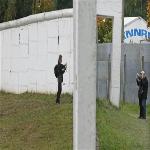30 September 2010

Photo: AP
Visitors take photos from both sides of the former East/West German border wall in Moedlareuth, Germany, 3 Oct 2008 (file photo)
On Sunday, October 3, Germany will celebrate 20 years of reunification. Our correspondent visited a village divided between East and West for four decades and reports that it stands today as a monument to the division of Germany.
Perhaps nowhere in Germany are the effects of the Iron Curtain understood better than the tiny village of Moedlareuth. The village of just 50 people was divided down the middle after World War II, and separated for four decades.
Two abandoned guard towers, a long white wall, a fence topped with barbed wire and border posts stand as a testament to what people endured for more than 40 years.
After Germany's unconditional surrender in 1945, the Allies divided occupied Germany into four military zones; French in the southwest, British in the northwest, the United States in the south, and Soviet in the east.
Two states emerged. West Germany, a parliamentary democracy, a NATO member, a founding member of what since became the European Union and one of the world's largest economies, and East Germany a totalitarian Stalinist dictatorship allied with the Soviet Union.
When Germany was divided, first came a fence, and then a wall in Moedlareuth, separating East from West and in one case, brother from brother.
Germany was reunited in 1990, after the collapse of the East German communist government and the opening of the Berlin Wall.
Now Moedlareuth is a museum that attracts 60,000 visitors a year to its open air exhibit.
There is also a film, that documents the divide. Tour guide Heiko Ultsch says it moves many visitors.
"There are people when they watch the movie in that museum they are still crying afterwards, after the movie, and so many people say we should never forget what happened in Moedlareuth or in Germany at all," said Ultsch.
American visitor Amy Ladd said she was struck that neighbors a few-hundred meters apart could not visit each other.
"I cannot imagine what it would be like to just be told all of a sudden that you cannot go over to the other side, overnight," she noted.
Twenty years ago the divide was broken and Germany officially reunified.
"I think the unification is certainly a wonderful thing for the Germans," said Terry Green, visiting from Florida. "The Eastern Germans did not have much of a life prior to the unification and now apparently they are starting to reap some of the benefits of Western civilization."
German Berg Ozminski says his children do not even feel the effects of the East-West divide because it occurred before they were born.
"It is no, no difference between East and West, young people for example, because they grow in the same way," explained Ozminski. "If you ask me if the reunification is done, I would say, 'Yes.'"
But there are still grounds for discontent over reunification on both sides. Unemployment in eastern Germany is far higher than in the West, and some western Germans complain they had to pay the costs of reunification.
"One of the surveys says 45 percent of the east Germans are feeling that they did not benefit, or did not profit by the reunification, but that means that more than a half do not think that," said historian Juliane Schutterle. "They are I think not so disappointed, not so frustrated."
Schutterle adds that criticisms overlook something far more important.
"They always think, 'We have to pay, we have to pay, they have modern highways, and modern buildings and modern infrastructure.' Yes, a lot of people may think that, but we have freedom right now, and this is one of the most crucial human rights we have and we achieved it," she said.
Many in Germany believe the reunification process is mostly complete, and hope Germans will stop thinking of the country in terms of East and West. This village, formerly known as little Berlin, shows clearly how divided Germany once was - and by contrast, how far it has come.